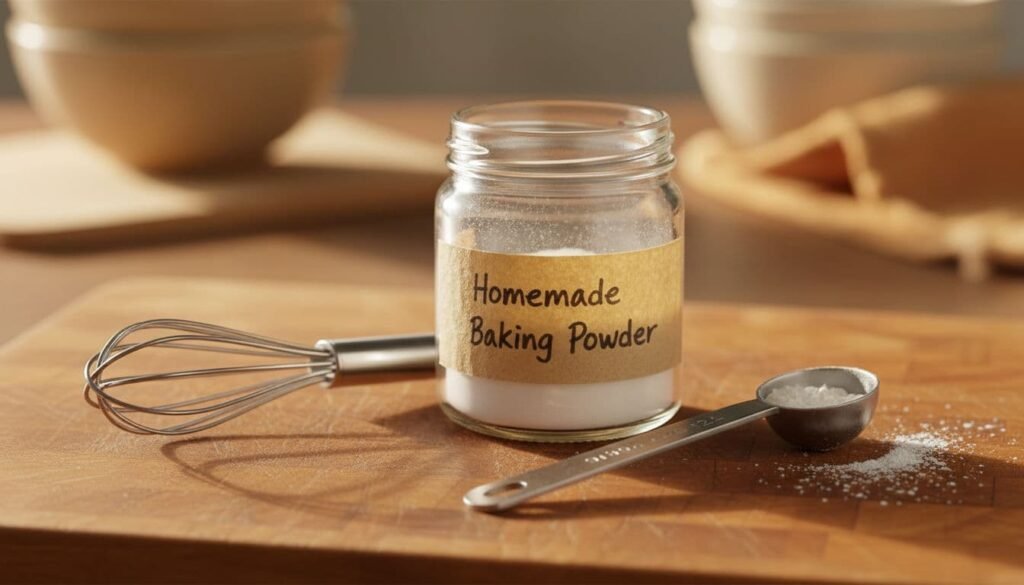How to Make Baking Powder at Home in 2 Minutes: Easiest Method
Ever start pancakes only to realize the baking powder tin is empty? I’ve been there, spatula in hand, hungry kids waiting. The good news is you can make a fresh batch in 2 minutes with pantry staples. You’ll get a reliable rise, clean ingredients, and full control over what goes into your family recipes.
Homemade baking powder is single-acting, which means it starts working as soon as it gets wet. Mix your batter and get it into the oven or onto the griddle right away for the best lift.
Here’s what you’ll find in this guide: what baking powder is, the exact recipe and ratios, storage tips, common mistakes, smart substitutes, and quick troubleshooting. I also included a simple test to check freshness, so your bakes turn out light and tender every time.
What Exactly Is Baking Powder and Why Does It Matter for Rise
Baking powder makes your batter rise. It is a blend of a base and an acid, plus a starch to keep it dry. When the base and acid meet moisture and heat, they create tiny bubbles of carbon dioxide. Those bubbles puff up pancakes, muffins, cakes, and biscuits.
Let’s keep the science simple:
- Baking soda is a base.
- Cream of tartar is a mild acid.
- When they meet moisture and heat, bubbles form and lift your batter.
There are two types:
- Single-acting: reacts once, as soon as it gets wet.
- Double-acting: reacts twice, first when wet, then again in the oven.
Homemade baking powder is single-acting. That means you need to bake right after mixing your batter. This is why your pancakes, muffins, and biscuits turn out best when you don’t let the batter sit.
A note on flavor: too much baking soda can taste bitter or soapy. The right ratio gives lift without changing the taste.
Key Takeaway: Homemade baking powder is single-acting, so mix and bake promptly for the best rise and clean flavor.
How to Make Baking Powder at Home (Exact Ratios and Steps)
Making baking powder at home takes just a few minutes and uses ingredients you probably already have. It gives your bakes a clean rise and lets you control what goes into your recipes.
Recipe Formula
- 2 parts cream of tartar
- 1 part baking soda
- 1 part cornstarch or arrowroot (optional if storing)
For 1 teaspoon:
- ½ teaspoon cream of tartar
- ¼ teaspoon baking soda
- ¼ teaspoon cornstarch or arrowroot (optional if using right away)
If your recipe calls for 2 teaspoons of baking powder, double the amounts above. For a month of baking, make 4 tablespoons and store them in an airtight jar. Use within 2–4 weeks for the best results.
Step-by-Step: Mix, Store, and Test
- Measure the ingredients using the ratio above.
- Whisk well to combine and remove any lumps.
- Store in a dry, airtight container if making extra.
- Label the jar with the date.
- To test freshness, drop a pinch into warm water. Quick fizzing means it’s active and ready to use.
Conversion: Replace 1 teaspoon of store-bought baking powder with 1 teaspoon of homemade.
Key Takeaway: Use 2 parts cream of tartar, 1 part baking soda, and 1 part starch if storing. One teaspoon of homemade equals one teaspoon of store-bought.
Ingredient Notes
- Cream of tartar: A dry, shelf-stable acid that helps your baked goods rise without changing the flavor.
- Baking soda: The base that reacts with the acid to create lift. Check that it’s fresh—weak fizz in water means it’s time to replace it.
- Cornstarch or arrowroot: Keeps the mix dry and shelf-stable. Skip it if you’re using the mix immediately.
Tips for Best Results:
- Use a completely dry spoon. Moisture triggers the reaction and weakens the mix.
- Keep the jar away from steam and stovetop heat.
- Make small batches to keep it potent and fresh.
Key Takeaway: Dry tools, airtight storage, and small batches give you the best rise and longest shelf life.
Quick Conversions and Scaling
Here’s an easy guide to scale your mix:
| Final Amount | Cream of Tartar | Baking Soda | Cornstarch/Arrowroot |
|---|---|---|---|
| 1 teaspoon | ½ tsp | ¼ tsp | ¼ tsp |
| 1 tablespoon | 1½ tsp | ¾ tsp | ¾ tsp |
| ¼ cup | 2 tbsp | 1 tbsp | 1 tbsp |
1 teaspoon of homemade baking powder = 1 teaspoon of store-bought in any recipe.
I like to pre-mix 1–2 tablespoons for a month of baking, then make a fresh batch.
Key Takeaway: Follow the 2:1 ratio, keep it dry, and make only what you need for the freshest, most dependable results.
Want to Master Kitchen & Meal Prep?
Knowing kitchen hacks like this is the first step. My complete ‘Finally In Control’ Planner Pack has a pantry inventory, grocery lists, and meal planning templates to keep your kitchen stocked and your week stress-free.
Smart Tips, Substitutes, and Troubleshooting
Baking soon after mixing matters. Since homemade baking powder is single-acting, it starts right away. Get your batter into the oven or skillet as soon as the wet and dry meet.
Storage advice:
- Use an airtight jar with a tight lid.
- Store in a cool, dry spot.
- Use within 2 to 4 weeks for the best lift.
- Label the jar with the date.
No cream of tartar? You can use baking soda plus an acidic liquid in your recipe. A common swap per 1 teaspoon of baking powder:
- Use 1/4 teaspoon baking soda plus 1/2 teaspoon lemon juice or vinegar.
- Reduce the liquid in the main recipe you’re making by 1/2 teaspoon (the amount added for the cream of tartar DIY) to keep the balance.
Troubleshooting:
- Bitter taste: Too much baking soda, or not enough acid. Stick to the ratio.
- Weak rise: Old baking soda or cream of tartar, or humid storage. Make a fresh batch and store airtight.
- Clumping: Moisture got in. Transfer to a dry jar, add fresh starch, and keep spoons bone-dry.
- Flat bakes: The Batter sat for too long. Mix and bake right away with homemade.
Key Takeaway: Bake promptly, store dry, and use a simple soda-plus-acid swap when you are out of cream of tartar.
When to Use Homemade vs Store-Bought
Homemade baking powder shines in quick recipes that go straight to the heat:
- Pancakes and waffles
- Muffins and quick breads
- Biscuits and scones
- Snack cakes that bake as soon as they are mixed
If your batter needs to rest or chill for a long time, store-bought double-acting can offer extra insurance. It gives a second lift in the oven. I still reach for homemade for most family breakfasts and weeknight treats because it is fresh, fast, and I always have the ingredients.
Key Takeaway: Use homemade for quick bakes. Choose double-acting for long rests or when timing is unpredictable.
Common Mistakes to Avoid
- Wrong ratio: Stick to 2 parts cream of tartar, 1 part baking soda, and 1 part starch if storing. Fix by re-measuring and whisking a new batch.
- Damp measuring spoons: Moisture triggers the reaction. Dry your spoons, then measure.
- Skipping starch for stored batches: Starch keeps it dry. If you plan to store it, include cornstarch or arrowroot.
- Old ingredients: Check dates and fizz-test baking soda. Replace stale items.
- Waiting to bake: Single-acting powder works right away. Mix and bake promptly.
- Uneven mixing: Whisk well to distribute. Lumps cause an uneven rise.
Key Takeaway: Dry tools, fresh ingredients, the right ratio, and prompt baking are the big wins.
FAQs About Homemade Baking Powder
Is homemade baking powder double-acting?
No. It is single-acting, so bake right away.
How long does DIY baking powder last?
Best within 2 to 4 weeks if stored dry and airtight.
Can I make homemade baking powder without cornstarch?
Yes. Skip the starch if you use it right away. For storage, arrowroot is a great alternative.
Is it aluminum-free and gluten-free?
Yes, when using pure ingredients like cream of tartar, baking soda, and cornstarch or arrowroot.
Will homemade baking powder change the taste of what I add it to?
Not if you keep the correct ratio. Too much baking soda can taste soapy.
Can I pre-mix it into dry mixes?
Yes. Store airtight, label with the date, and keep moisture away.
Homemade baking powder is simple, clean, and reliable as long as you store it dry and bake promptly. For more practical kitchen tips that fit a busy home, this resource is helpful: Kitchen Essentials for Baking and Cooking.
Wrap-up
Making baking powder at home is simple and fast. With the 2:1 ratio of cream of tartar to baking soda, you can mix a small batch and bake right away for a fresh, dependable rise. Keep it dry, test for a quick fizz, and remember to bake promptly since it is single-acting.
Try a teaspoon today and flip a stack of pancakes or pop a pan of muffins in the oven. You will taste the difference in the lift and the clean flavor. Be sure to keep this baking powder recipe guide handy for stress-free baking days. You have everything you need, right in your pantry.



